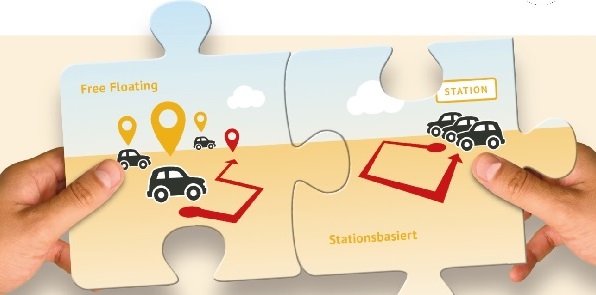By Henrik Becker, Francesco Ciari, Kay W. Axhausen, (ETH Zurich, Institute for Transport Planning and Systems, Stefano-Franscini-Platz 5, 8093 Zurich, Switzerland)
Free-floating car-sharing schemes operate without fixed car-sharing stations, ahead reservations or return-trip requirements. Providing fast and convenient motorization, they attract both public transportation users and (former) car-owners. However, given their highly flexible nature and different pricing structures, previous findings on user groups and environmental impact of station-based car-sharing may not be easily transferable. Therefore, this research uses survey data to compare user groups and usage patterns of a free-floating and station-based car-sharing service both operating in the city of Basel, Switzerland. The findings suggest, that the schemes indeed attract different user groups and are also used differently. Moreover, we see, that car-sharing membership is governed by other factors than car-sharing activity.
Introduction
Since its first implementation in the late 1940s, car-sharing has long been a niche service, unable to attract a substantial share of the urban population. This was due to both the inflexibility of car-sharing schemes themselves and the social importance of car ownership. In recent years, the game has changed; modern information technology has allowed the schemes to become more user-friendly and social trends favoring sharing over ownership support their adoption.
One of the latest additions to the car-sharing market is free-floating car-sharing. Instead of relying on designated car-sharing stations, it allows customers to pick up and drop off the vehicle anywhere within a city-wide service area. Through this innovation, it removed the obstacles of station-based car-sharing, such as required advance reservations and restrictions on a set of pre-defined stations as trip origins and destinations.
The introduction of free-floating car-sharing in Basel allows investigation of the usage and impacts of two different forms of car-sharing in a Swiss context for the first time. Using new data, this research allows direct comparison of user groups and usage patterns for a station-based and a free-floating car-sharing scheme operating in the same city. The results are a first step towards better understanding the specific market niche of free-floating car-sharing.
Car-sharing schemes in Basel: free-floating car sharing Vs. fixed car-sharing stations.
At this point in our research, Basel is the only city in Switzerland with both station-based and free-floating car-sharing schemes.
The station-based car-sharing scheme currently operating in Switzerland dates back to 1987. Available not only in larger cities like Basel, but also in smaller towns and villages, it is probably the only scheme worldwide offering a seamless system serving a whole country. It offers access to almost 3000 vehicles of various types at 1500 car-sharing stations. Members can either: buy a share of the cooperative (one-time investment of 1250 CHF of which 1000 CHF is refundable upon exit; 1.00 CHF = 0.68 USD at purchasing power parity, OECD 2015), or subscribe to the service for an annual fee of 200–300 CHF. The membership fee can be substantially reduced to CHF 25 for holders of a public transportation subscription, although these members pay higher rental fees. Rentals are charged both by the hour and by distance travelled (3–4 CHF/h plus 0.50–1.00 CHF/km, depending on the vehicle type and time of the day).
In August 2014, a free-floating car-sharing pilot program was launched in Basel, Switzerland. 120 cars of the type VW Up were distributed around the city. They can be located via a website or smartphone-app and reserved up to 15 min in advance. Customers must pay a small registration fee (25 CHF) upfront and then only pay on a per-use basis. The fare structure distinguishes between parking and driving time; customers are charged per minute (fares: 0.41 CHF/min driving and 0.24 CHF/min parking). At the end of the journey, the vehicle can be parked on any public parking spot within the service area, where it then becomes available for other members.
Although both the station-based round-trip car-sharing scheme and the free-floating car-sharing scheme are operated by the same company, they are run entirely separately from each other. As a consequence, customers wishing to use both schemes must register for each scheme separately.
Discussion
Results from the questionnaires largely confirm and extend findings from other studies on both station-based and free-floating car-sharing. For example, overall results confirm that both schemes mainly attract younger and highly educated people living in households with few private cars (Burkhardt and Millard-Ball, 2006; Firnkorn and Müller, 2012 ; BMW et al., 2016). However, the model highlights important differences; while station-based car-sharing seems to be adopted mainly by self-employed workers who appreciate the flexibility of using a car when needed, free-floating car-sharing thrives among young men with higher incomes, whose home location is not optimally served by public transportation.
Results also suggest that the two car-sharing schemes are not only used by different customers, but also in different ways; station-based car-sharing is mostly used in situations actually requiring a car (c.f. Fig. 4), free-floating car-sharing is used when it helps save time compared to other alternatives (c.f. Fig. 3) – an effect which also appears in the WiMobil study (BMW et al., 2016).
Please, note that this is just a summary. Read the full article at: http://www.sciencedirect.com/science/article/pii/S0965856416306255















